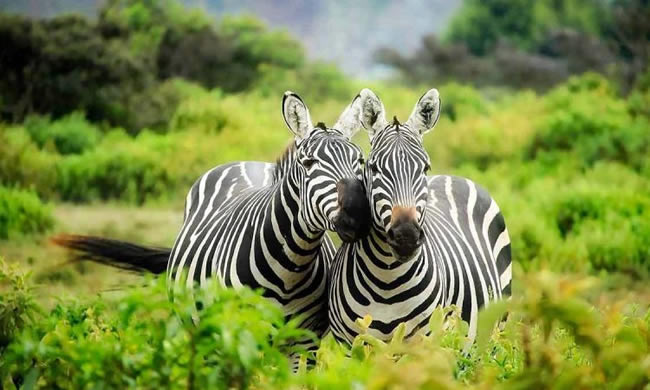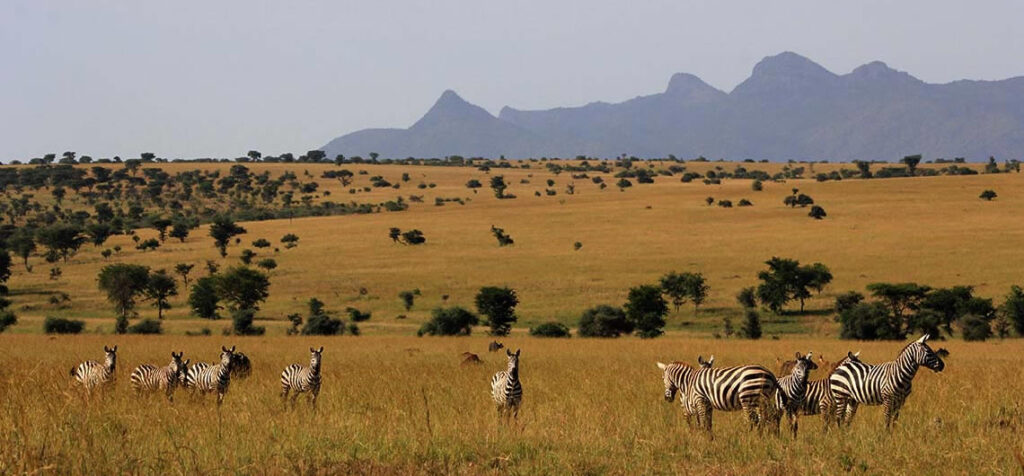Located only 240 km away from the capital city in Kiruhura, Isingiro and Mbarara districts, Lake Mburo National Park is the nearest savanna area from Kampala capital. It is located along the Kampala-Mbarara-Kabale highway and takes about 4 hours to get there. The Park is also the smallest savannah national park in Uganda covering only 370sq. km and yet consists up to 5 scenic lakes. The Park is known for mostly zebras, antelopes, giraffes, buffaloes, Elands and also the only place in Uganda where you can come across the Impalas.
First gazetted in 1933 as a controlled hunting area, it was later transformed into a game reserve in 1963, however it was encroached on by the Bahima and Banyankole who grazed their cattle until it was upgraded to National Park status in 1983 during the Obote regime. This move also acted as a punishment to the Banyankole as it was believed that they were supporting Obote’s political rivals. The evicted occupants weren’t compensated and therefore, protested against the park’s formation. Eventually, some of them divided small pieces of land that surrounded the park amongst themselves to rear their animals.
Lake Mburo from which the park derives its name is said to have formed when one of the two brothers who were staying within the savannah plains had a dream about heavy rains flooding the area, he shared the dream with his brother Mburo who never took it seriously, Kigarama decided to evacuate the place and during that time dreams were taken seriously. The dream later became reality as the place flooded and sadly Mburo drowned. The waters formed what we now know as Lake Mburo while the dry neighboring hilly areas are called Kigarama.
This area consists of riparian woodlands, acacia trees, bush thickets, forested gorges, rocky ridges and different types of grasses that best describe the savannah vegetation. The lakes and wetlands in the park support survival of over 68 mammal species and a variety of birds like African fin foot. The area is covered by ancient Precambrian metamorphic rocks that were formed a million years ago hence contributing to the aesthetic scenery enjoyed at the park.
Attractions in Lake Mburo National Park.
Wildlife.

Among the 68 mammal species are herds of antelopes, elands and lots of Zebras that can be spotted as you travel along the Kampala-Mbarara highway. Other animals are buffaloes, reed bucks, Oribis and Defassa waterbucks that feed on the green grasslands. Some nocturnal animals like hyenas, leopards can also be found in this park.
Lakes.
The Park consists of 5 different lakes and the biggest being Lake Mburo, its fresh waters favor the breeding of different types of fish like Tilapia, Mud fish, Haplochromes and lung fish, tourists can go fishing using different fishing methods like hooks and arrows. There are about 6 species of fish that inhabit these lakes. The lakes are great inhabitants of aquatic life such as Hippopotamuses, crocodiles and water birds like the pelicans and shoebills.
Birds.
Over 313 species of birds call the park home, these include the brown parrot, green wood hoopoe, the rare white winged warbler, African grey hornbill, the crested francolin and lots more. Some birds can also be seen from the Rwonyo camp like the African watted lover Rufous and the Red necked spur fowl.
Activities in Lake Mburo National Park.
Wildlife game drives.

These game drives allow one to see the different animal species within the park such as the large herds of the zebras, antelopes, Impalas and buffaloes. During these game drives you can also see the different sections of the parks and birds too. It is recommended to always have a game ranger on board to be able to point out the different animal and bird species that you come across.
Boat cruise.
Enjoy boat cruises across the lake as you get closer to the flora and fauna along the water banks such as antelopes and jackals taking water, hippopotamuses and crocodiles swimming. Water birds like pelicans and shoebills that feed on the fish are not missed during these excursions. In order to see most of these animals at once, it is best to visit the place during dry seasons where they always gather to quench their thirst.
Fishing.
There are over 6 different species you are likely to catch on any of the 5 lakes found in the park, the best fishing spot is at Mazinga where you can catch fish like Tilapia, mud or cat fish and many more.
Nature Walks.
Take part in guided walks around the park, these are always in the company of a game ranger. The walks lead you to the salt lick from the Rwonyo camp.
Visiting the salt lick.
The salt lick is a pond-like feature whose waters are salty, you’ll find animals licking the soils surrounding it. Visiting this place is usually during the nature walks.
Horse-riding safari.

Similar to game drives with the only difference being that instead of enjoying a vehicle ride, you instead see animals while on the horse’s back. Ride the horses around the park. This is the also only park where horse-riding can be done. This is one-of-a-kind experience of viewing wildlife. Horses can be hired from Mihingo Safari Lodge.
Bicycle tours.
Ride among the zebras, this experience allows you to get closer to nature. Hire bikes from the park and enjoy guided rides while viewing numerous wildlife animals. You can ride within the park or around the surrounding communities.
Best Time to Visit.
Visiting the park can be possible all year round, for the best experiences of seeing most rare animals, it’s better to visit during the dry season which happens between June to September / October and December to February.
